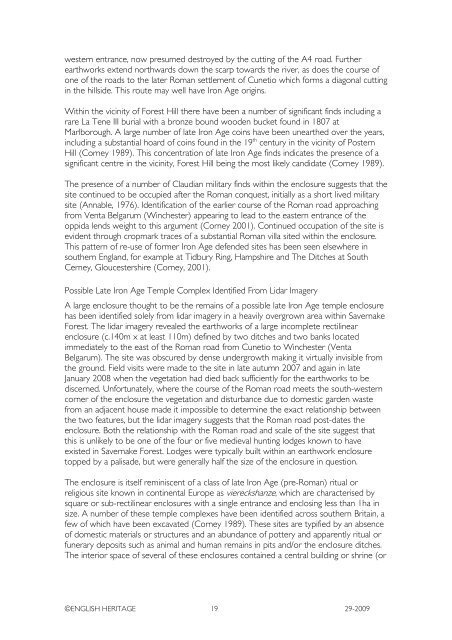savernake forest a report for the national mapping ... - English Heritage
savernake forest a report for the national mapping ... - English Heritage
savernake forest a report for the national mapping ... - English Heritage
You also want an ePaper? Increase the reach of your titles
YUMPU automatically turns print PDFs into web optimized ePapers that Google loves.
western entrance, now presumed destroyed by <strong>the</strong> cutting of <strong>the</strong> A4 road. Fur<strong>the</strong>r<br />
earthworks extend northwards down <strong>the</strong> scarp towards <strong>the</strong> river, as does <strong>the</strong> course of<br />
one of <strong>the</strong> roads to <strong>the</strong> later Roman settlement of Cunetio which <strong>for</strong>ms a diagonal cutting<br />
in <strong>the</strong> hillside. This route may well have Iron Age origins.<br />
Within <strong>the</strong> vicinity of Forest Hill <strong>the</strong>re have been a number of significant finds including a<br />
rare La Tene III burial with a bronze bound wooden bucket found in 1807 at<br />
Marlborough. A large number of late Iron Age coins have been unear<strong>the</strong>d over <strong>the</strong> years,<br />
including a substantial hoard of coins found in <strong>the</strong> 19 th century in <strong>the</strong> vicinity of Postern<br />
Hill (Corney 1989). This concentration of late Iron Age finds indicates <strong>the</strong> presence of a<br />
significant centre in <strong>the</strong> vicinity, Forest Hill being <strong>the</strong> most likely candidate (Corney 1989).<br />
The presence of a number of Claudian military finds within <strong>the</strong> enclosure suggests that <strong>the</strong><br />
site continued to be occupied after <strong>the</strong> Roman conquest, initially as a short lived military<br />
site (Annable, 1976). Identification of <strong>the</strong> earlier course of <strong>the</strong> Roman road approaching<br />
from Venta Belgarum (Winchester) appearing to lead to <strong>the</strong> eastern entrance of <strong>the</strong><br />
oppida lends weight to this argument (Corney 2001). Continued occupation of <strong>the</strong> site is<br />
evident through cropmark traces of a substantial Roman villa sited within <strong>the</strong> enclosure.<br />
This pattern of re-use of <strong>for</strong>mer Iron Age defended sites has been seen elsewhere in<br />
sou<strong>the</strong>rn England, <strong>for</strong> example at Tidbury Ring, Hampshire and The Ditches at South<br />
Cerney, Gloucestershire (Corney, 2001).<br />
Possible Late Iron Age Temple Complex Identified From Lidar Imagery<br />
A large enclosure thought to be <strong>the</strong> remains of a possible late Iron Age temple enclosure<br />
has been identified solely from lidar imagery in a heavily overgrown area within Savernake<br />
Forest. The lidar imagery revealed <strong>the</strong> earthworks of a large incomplete rectilinear<br />
enclosure (c.140m x at least 110m) defined by two ditches and two banks located<br />
immediately to <strong>the</strong> east of <strong>the</strong> Roman road from Cunetio to Winchester (Venta<br />
Belgarum). The site was obscured by dense undergrowth making it virtually invisible from<br />
<strong>the</strong> ground. Field visits were made to <strong>the</strong> site in late autumn 2007 and again in late<br />
January 2008 when <strong>the</strong> vegetation had died back sufficiently <strong>for</strong> <strong>the</strong> earthworks to be<br />
discerned. Un<strong>for</strong>tunately, where <strong>the</strong> course of <strong>the</strong> Roman road meets <strong>the</strong> south-western<br />
corner of <strong>the</strong> enclosure <strong>the</strong> vegetation and disturbance due to domestic garden waste<br />
from an adjacent house made it impossible to determine <strong>the</strong> exact relationship between<br />
<strong>the</strong> two features, but <strong>the</strong> lidar imagery suggests that <strong>the</strong> Roman road post-dates <strong>the</strong><br />
enclosure. Both <strong>the</strong> relationship with <strong>the</strong> Roman road and scale of <strong>the</strong> site suggest that<br />
this is unlikely to be one of <strong>the</strong> four or five medieval hunting lodges known to have<br />
existed in Savernake Forest. Lodges were typically built within an earthwork enclosure<br />
topped by a palisade, but were generally half <strong>the</strong> size of <strong>the</strong> enclosure in question.<br />
The enclosure is itself reminiscent of a class of late Iron Age (pre-Roman) ritual or<br />
religious site known in continental Europe as viereckshanze, which are characterised by<br />
square or sub-rectilinear enclosures with a single entrance and enclosing less than 1ha in<br />
size. A number of <strong>the</strong>se temple complexes have been identified across sou<strong>the</strong>rn Britain, a<br />
few of which have been excavated (Corney 1989). These sites are typified by an absence<br />
of domestic materials or structures and an abundance of pottery and apparently ritual or<br />
funerary deposits such as animal and human remains in pits and/or <strong>the</strong> enclosure ditches.<br />
The interior space of several of <strong>the</strong>se enclosures contained a central building or shrine (or<br />
©ENGLISH HERITAGE 19 29-2009

















